WEBLOG:
I’ve been hearing about electrostatic headphones for a while now, and they are usually spoken about with reverence since some of the finest and most expensive headphones ever made were elecstrostatic. Stax is currently the king of electrostatic headphones, and the SR-007mk2 is their flagship product. It’s also known as the Omega 2 mk2, or O2 mk2. The Omega name comes from the first generation of the model due to the circular shape of the driver housing, which was a departure from Stax’s previous rectangular designs. Then there was the Omega 2, which was the next generation, and sometimes referred to as mk1 version because the next version was called the mk2. After hearing about the flagship Stax models for so long, I finally got to hear one in person a few months ago when I went to a headphone shop in Taiwan and tested my Denon AH-D7000 against it in a comprehensive listening session. I fell in love with the flagship Stax sonic signature right then and there, and I knew I would have to own a Stax rig eventually. The 007mk2 (powered by the SRM-717) made the D7000 sound artificial and annoying (you can read my testing of the two headphones against each other in this blog entry), and it was like a revelation–to hear the electrostatic technology and how different it sounded compared to the familiar dynamic headphones. Here’s a photo from when I first listened to the 007mk2 months ago in a headphone shop in Taiwan:
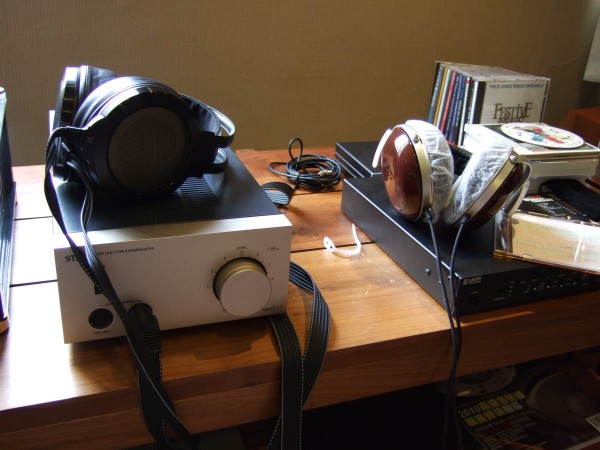
Planning the Purchase
Since that listening session months ago in Taiwan, I had been planning my Stax rig and did a lot of research into which of the Omega 2 models or amps I should get. After careful consideration, I decided to go with the SR-007mk2 and the SRM-717 amp. Although many people prefer the mk1 version, it is out of production and I always avoid buying anything that is no longer in production unless there are very compelling reasons. Based on all that I have read about the mk1, it isn’t significantly different from the mk2–perhaps even a bit less satisfying, and since I have already heard the mk2 and loved it, I had no reason not to stick with the model I fell in love with. As for the SRM-717, although it is no longer in production, it is the amp that powered the mk2 that I heard, and it’s widely considered one of the best amps Stax ever made, except for the ridiculously expensive models that cost as much a new compact car. Since I have no interest in tube gear (more hassle to deal with than solid state), and the other currently in production solid state electrostatic amp of repute (Kevin Gillmore’s KGSS) costs twice as much and has a waiting list–one that seems to get longer without warning sometimes, I decided to take the risk and get the 717–in fact I got the exact same unit I listened to months ago. It was the store demo unit that’s been used for a few years, and it’s in perfect condition since it’s only been listened to about twice a week or so on average, and only by reservation ahead of time with the store for a private listening session. When it isn’t being auditioned, it is kept in the storage box, so it’s not exposed to anything harmful. Considering the fact that if I had bought one from a private owner who listened to it moderately often–say three to four times a week or so, and for about an hour or so each time, that’s far more wear and tear than the store demo unit, especially if the person is a smoker, has kids, and the unit is always sitting out there on a shelf or desk, exposed to dust and other elements.
Preface
Since ordering the 007mk2 and the 717, I’ve been waiting anxiously for them to show up, and now that I’ve got the Stax rig in the studio and have been putting it through its paces, I’m ready to give my official assessment. I will not be comparing the Stax to the Denon AH-D7000 in this review since I already did that previously, and also because I sold the D7000 recently. Without EQ, the D7000 is excessively bright and has a recessed mid range. While it can be very satisfying with my EQ settings, and it has one of the most fun and powerful bass in a pair of headphones, I just couldn’t justify keeping a pair of high-end headphones that require at least three bands of EQ to sound acceptably neutral. I’ll definitely miss that bass though, even if it has a prominent resonance that colors everything in the lower frequencies. In a way, it’s sort of like if a girl’s got a lot of junk in her trunk–even though you’ll always notice it and it will always alter the overall proportions of her figure, it’s not necessarily a bad thing if you are into it.
I will be discussing how the 007mk2 compares to the Audez’e LCD-2, Sennheiser HD650, and Audio-Technica ATH-M50, but I will not be using the Klein + Hummel O 300D as a reference like I used to, since at this point I feel that unless one has access to an anechoic chamber or a high-end mastering studio, there will always be room modes interfering with the ideal neutral/flat response, and this is not something you can remedy with acoustic treatment and room correction products like the IK Multimedia ARC System (or even if you use them in conjunction). If you have a null, it’s going to be there no matter what, and no reasonable amount of acoustic treatment will fix it unless you are an acoustic expert and can do precise mathematical calculations and know exactly what kind of trap or resonator to construct, to what exact specifications, and where exactly to place them. Even then, there’s always the possibility that the room itself does not have enough space for the treatment. While high-end reference studio monitors will always sound more dimensional and visceral, I feel that today’s high-end headphones have come a long way and can get very close in terms of resolution and frequency response, but at the same time do not have deal with room modes, thus are inherently more trustworthy than speakers (assuming the headphone is fairly neutral and accurate to begin with, and not some cheap earbuds that comes bundled with portable players). The old caveat of the “in your head” extreme stereo separation of headphones are also irrelevant today when we have crossfeeds that takes care of the problem, and they’re not just any crappy ol’ crossfeed, but quality ones like the Isone Pro or Redline Monitor in software form, and in hardware units like the SPL Phonitor, or Grace Design M902.
Ergonomics, Comfort, and Aesthetics
Right away, you see how different the packaging is for such a high-end headphone–it comes in a very nicely designed box and briefcase:
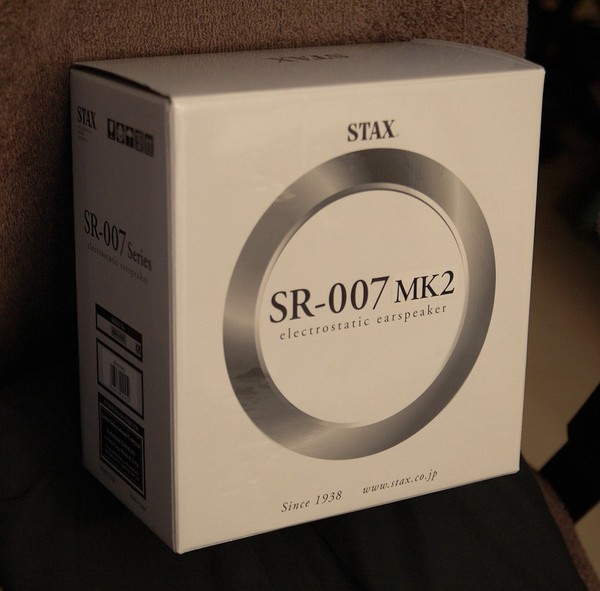
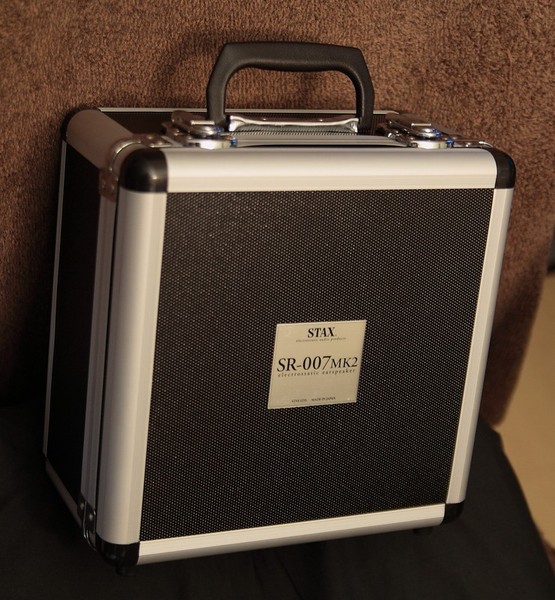
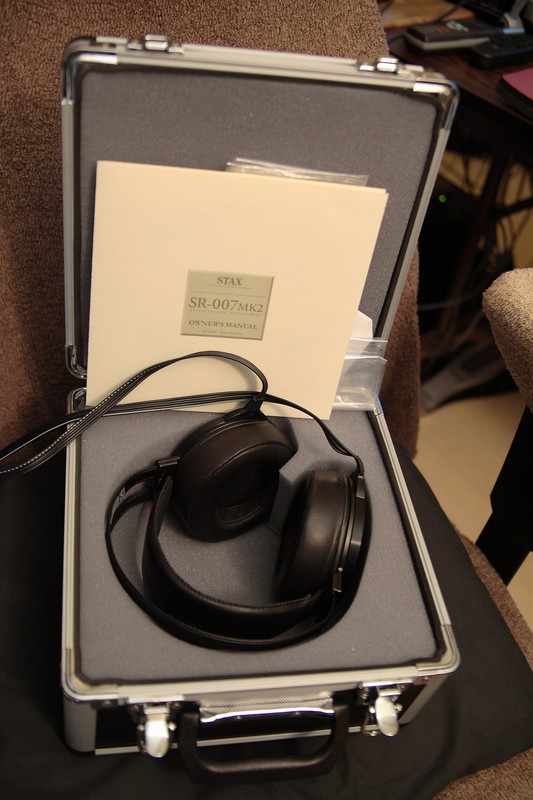
I agonized over whether to get the 007A, which is the Japan-only model and is silver and black, or the 007mk2, which is the model for the rest of the world, in black. Here’s how they compare–this is the official photo of the 007a from Stax:
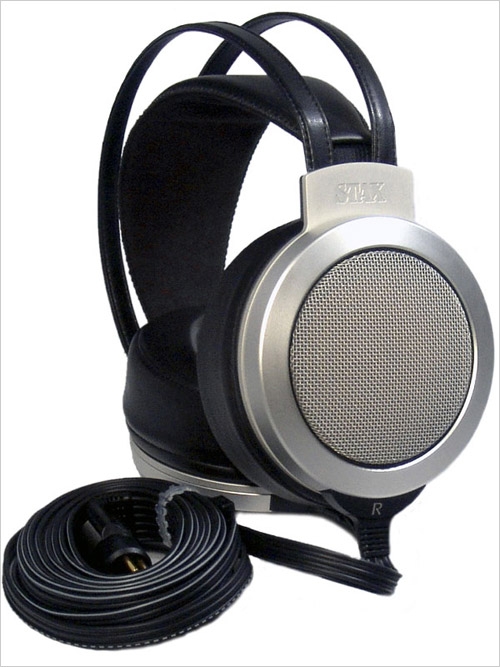
and here’s my casual shot of the 007mk2:
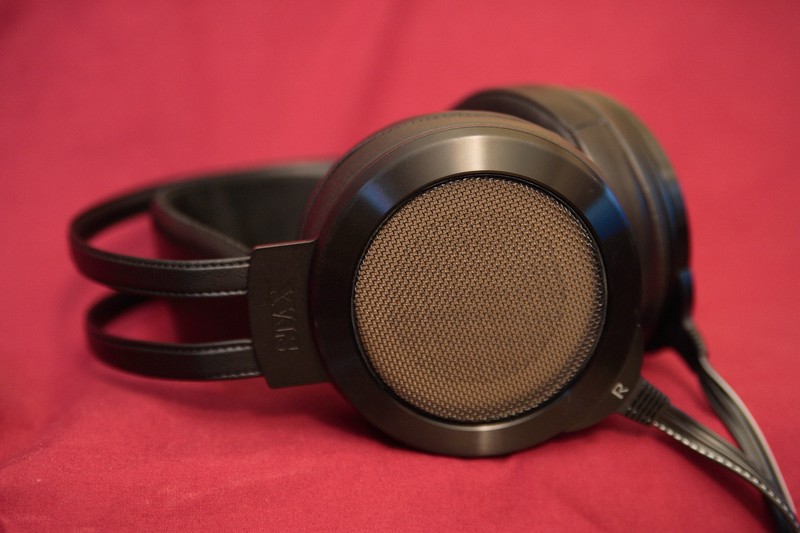
While initially I thought the silver and black looked more exciting and futuristic, I eventually picked the black since it’s more elegant and classy (I’m not a flashy guy after all, and Elena preferred the black version too). Turned out the dealer I got it from only sell the black one anyway, and I’d have to buy from Japan if I wanted the silver version. Here are more shots of my 007mk2:
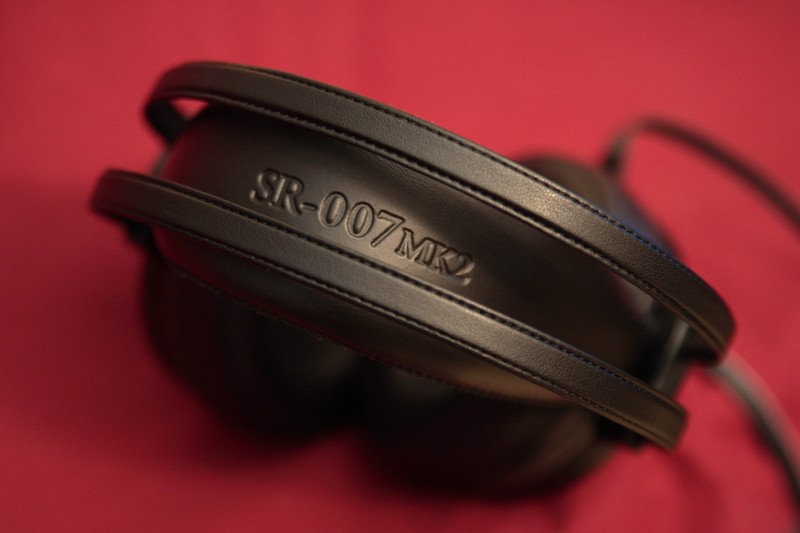
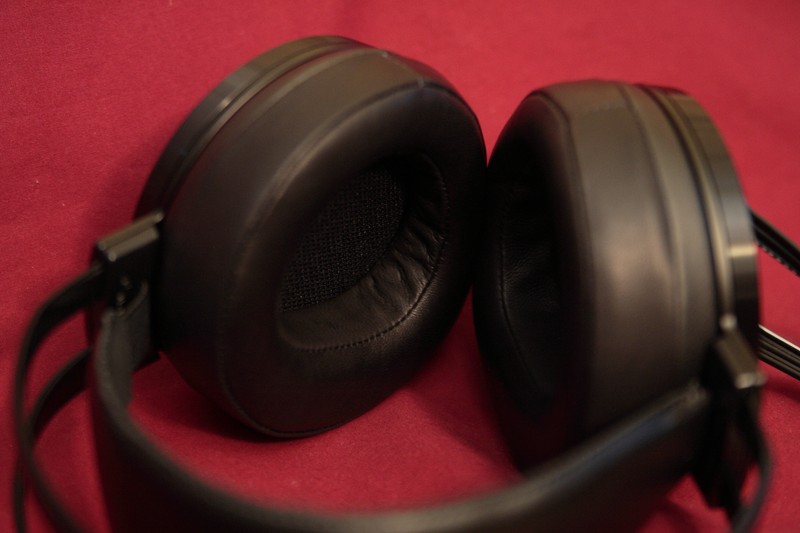
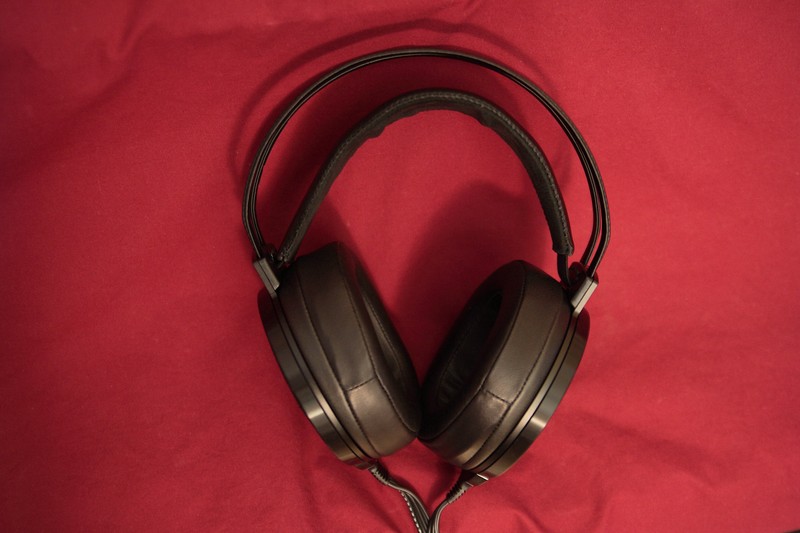
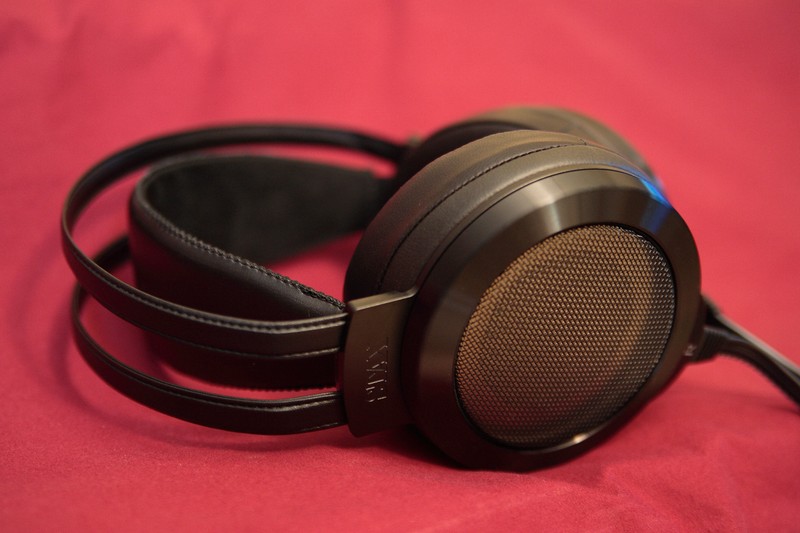
Since I already had experience with the 007mk2 before, I already knew how it fits, and the oo7mk2 is one of the most comfortable headphones I’ve ever worn. It’s about middle of the road in terms of weight, and the clamping force is on the lighter side. It’s a bit firmer than the D7000, but less than the HD650, and roughly about the same as the M50. The headband is self-adjusting, which is a welcome change since I hate dealing with adjustable headbands, and I always end up just taping them so they no longer get changed accidentally. I did notice one problem right away though–the leather earpad on the right side keeps slipping out like so:
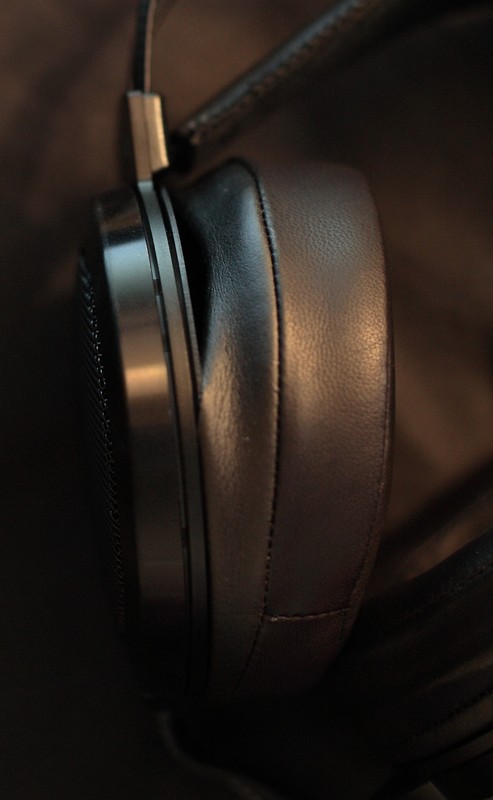
It was time-consuming to try to stuff it back in, so eventually I decided to just tape the damn thing down:
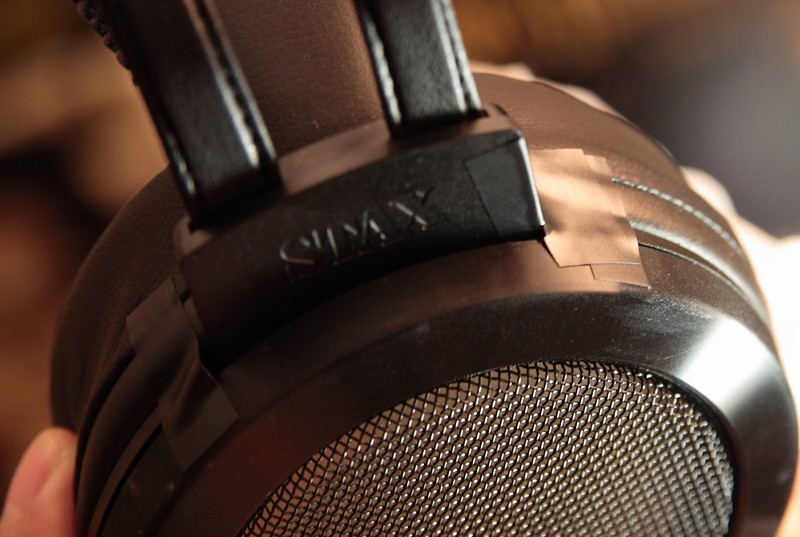
I also taped the earcups to the anchoring frame since they rotate freely and is kind of annoying, as that changes the angle of the drivers as well as the proper sealing of the earpads. The 007mk2 has D-shaped earcups, and for me, the best seal happens when the curve of the D is facing the front of my face, and I simply taped the earups down that way.
And since I hate sweaty ears from leather or pleather earpads, I put sanitary covers on them, like I do with all my other headphones (and no, the sanitary covers do not alter the sound of the headphones at all):
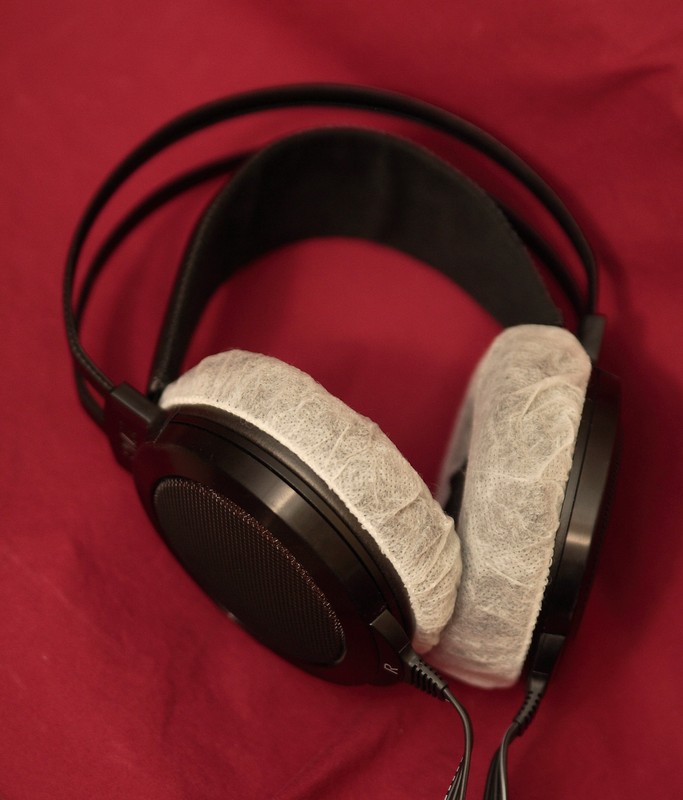
Here’s the SRM-717:
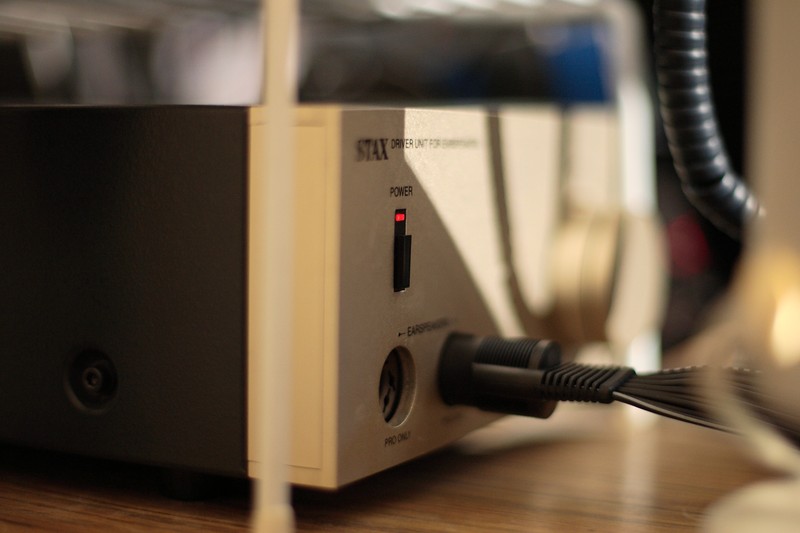
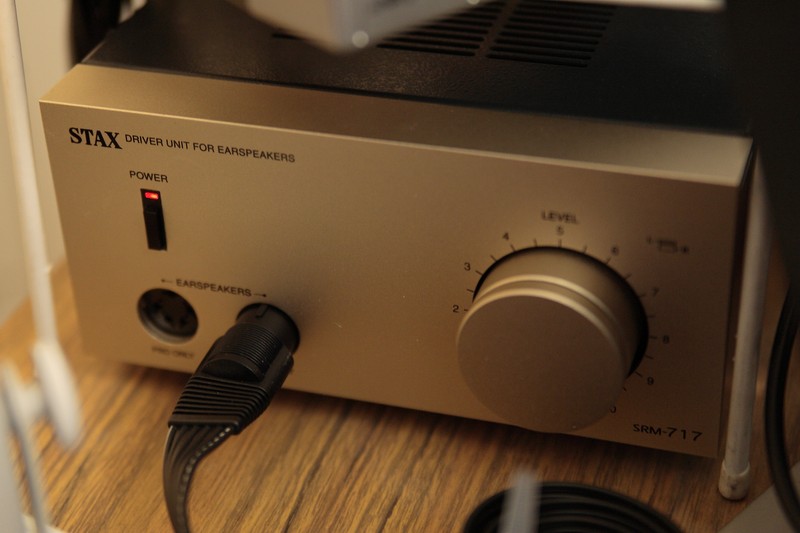
The Sound
Now let’s get into the most important part–how the Stax rig sounds (I’ll only be talking about the 007mk2 and not the 717, since I don’t have other electrostatic amps to compare the 717 with, so just keep in mind the 007mk2 is being powered by the 717). First, I want to get this out of the way–it was a bad idea to take the Denon D7000 with me to Taiwan as the headphone to use to test other headphones. I wasn’t as familiar with the D7000 back then since I had just gotten it, and I wish I had taken the M50 or the HD650 instead, because the D7000 is so skewed in its sonic signature that it just wasn’t neutral and accurate enough to be used as a reference of any kind. When I compared the 007mk2 to the D7000, the Stax walked all over the Denon, and with good reasons too–since the Stax is much more neutral. If I had the LCD-2 back then and used it to test against the 007mk2, my impression of the Stax flagship would’ve been quite different–it would not have been blatant adoration and love at first listen–it would’ve been more like, “Hmm, this is very nice and unique, but is it objectively better?” In fact, I had planned to take the LCD-2 with me to Taiwan again to conduct a listening test with the Stax rig, just so I could be sure that my initial love for it could be confirmed; however, my travel plan was canceled last minute. I then decided to just buy the Stax rig and then do my tests in my own studio, which would allow me time for far more comprehensive testing. I knew that flagship Stax products retain their value very well, so it wasn’t something I worried about and it made the purchase easier (otherwise, spending over $3,000 on a headphone rig would’ve made me really nervous).
So, just how does the 007mk2 sound? The adjectives I would use are elegant, refined, classy, light-footed, quick, detailed, warm, yet analytical. Does it have faults? Yes, I would say that it has two–one is that the treble is a bit etched, similar to the way that the M50 has a slightly metallic weight to its treble, and the other is that while it does have authoritative bass and a full-bodied sound, overall it doesn’t feel as connected to your body as dynamic headphones do. I suspect this is due to the inherent qualities of the electrostatic transducers–it feels light and delicate, as opposed to the substantial weight of moving-coil transducers. Whether one sounds better than the other is a subjective matter.
When I purchased the LCD-2, I did it hoping that it would get me very close to the flagship Stax sound I fell in love with, and I had such expectations because some people have said that it sounds very similar to the Omega 2. When I got the LCD-2, I didn’t feel it sounded like the O2 mk2, and based on my memory of how the O2 mk2 sounded, the LCD-2 didn’t have the same detailed textures, detailed treble, and that very classy and natural sound. The problem with my recollection of how the O2mk2 sounded is that it was based on how the Denon D7000 compared, and the D7000 is very different compared to the LCD-2. Now that I have both the LCD-2 and the O2mk2 in my studio, I understand why some people have said they sound alike. I have to agree with that in some ways, they do–particularly the overall sonic signature in terms of frequency response. Take a look at these frequency response graphs I captured below. (I used the measuring mic that came with the IK Multimedia ARC System, fit it into the hole of a CD, which is used to seal the earcup of the headphone being tested, then played a pink noise observed with Voxengo’s SPAN spectrum analyzer (set to 3dB slope, 8192 block size, real-time average, and maximum average time). This obviously isn’t as accurate as an expensive dummy head with ear canals that cost tens of thousands of dollars, but at the very least it allows me to see the differences in each headphone’s general frequency response–even if it’s only the relative differences between headphones, as opposed to perfectly accurate measurement of the response itself.) When you look at the graphs, you’ll see just how similar the O2mk2 and LCD-2 are:
Stax 007mk2
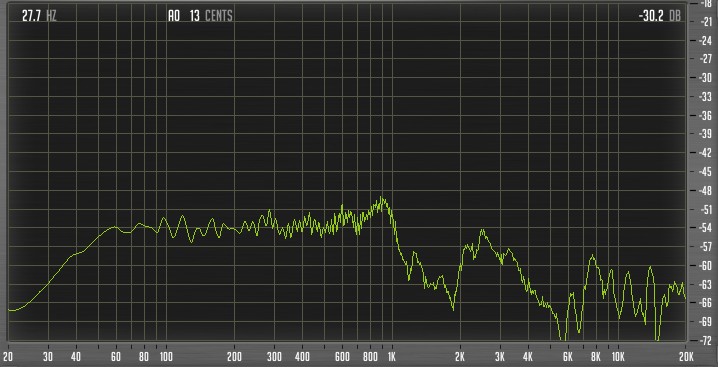
Audez’e LCD-2
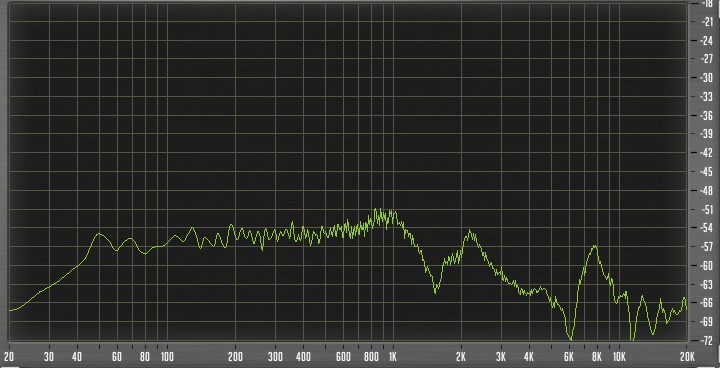
To put things in perspective, look at how different the graphs of the other headphones look:
Sennheiser HD650
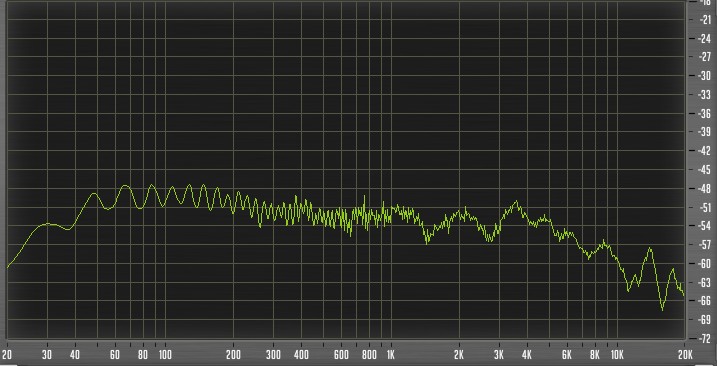
Audio-Technica ATH-M50
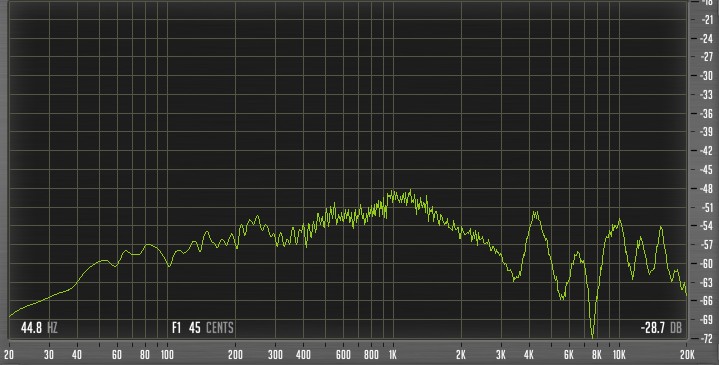
Equation RP-21
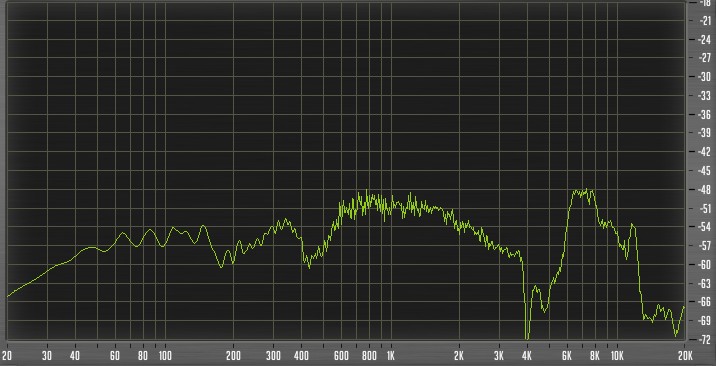
Pioneer SE-DJ5000
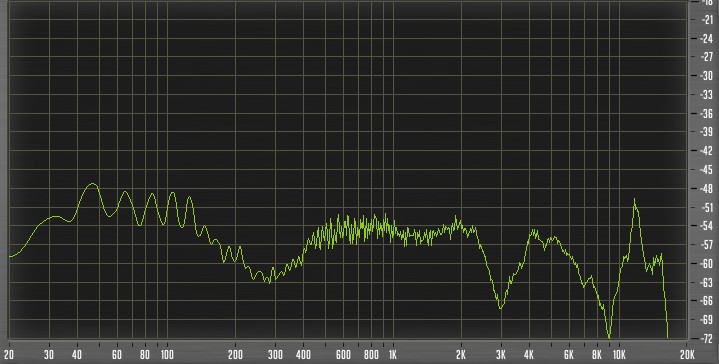
Now it becomes very obvious that the O2mk2 and the LCD-2 are the most similar, while the other headphones are dramatically different.
One similarity I noticed right away is that both don’t have as much bite in the mids as most headphones do–this is particularly noticeable on musical material with instruments like the distorted electric guitar or a brass section. On both the O2mk2 and the LCD-2 these types of instruments tend to sound a bit polite. In my past review of the LCD-2, I had mentioned that it’s a bit soft in the 2KHz~3KHz range, which is what’s causing the lack of satisfying bite on certain musical material, and it’s a similar issue with the O2mk2. The same material with the HD650 or M50 have a lot more bite, and it’s not subtle, especially to people who appreciates distorted guitars rocking out, or the funkiness and majesty of the brass section. The other similarities are that both are more full-bodied sounding than most headphones and have a warmer presentation overall, and have substantial bass weight and extension but without being excessive.
Now let’s talk about the differences between the O2mk2 and the LCD-2. The most obviously difference is the sense of weight. While both headphones have a full-bodied sound, the LCD-2 has this sense of weight that’s unlike any other headphones I’ve heard, and it’s one of the most common observations that anyone who’s heard the LCD-2 makes right away. It’s as if the entire audible frequency range is represented fully, resulting in a thick and dense consistency. Creamy is probably the word I’d use. That’s right–I just called the LCD-2 creamy. You might get the impression that the LCD-2 is slow and muddy sounding from the above description, but that’s not the case at all–it is actually detailed and articulate. Although it may not have as much bite in the mids and and punch in the upper bass compared to some other headphones, some people might prefer this more neutral and flat presentation, while others would prefer a more exciting and fun sonic signature.
The O2mk2 in comparison, is much lighter, even if the bass is still substantial and the overall sound is full-bodied. This lightness has nothing to do with frequency response and has to do with the physical quality of the electrostatic driver, which is much thinner and moves much quicker than moving coils using magnets, and I think this is what contributes to the delicate and classy sound that electrostat fans love. Whether you like that lightness depends on your subjective taste. For some people they might feel it’s less visceral and disconnected from the center of your gravity, while others would prefer the effortless presentation–a bit like sound forming out of thin air near your ears, as opposed to coming out of your head.
When I listen to the O2mk2, I associate it with an elegant and classy girl who’s very intelligent, soft-spoken, polite, thoughtful, but confident and strong-willed. I remember in one of the Headphone Musume illustrations (a Japanese headphone review publication where each review is accompanied by an illustration of a girl wearing the model being reviewed, and each illustration has a different girl and a different premise), the O2 was represented by a pensive girl wearing a kimono, and outside the window the trees are the colors of autumn. I think that illustration nailed it–that’s how the O2mk2 feels to me. On a more personal note, one of my favorite albums is Rouge et Bleu by Kawai Sonoko (her finest album IMO, where she transitioned from a bubbly teen pop idol into a serious songwriter, composer, and producer), and when I listen to my favorite songs from that album on the O2mk2, I feel like they’re made for each other. The album is elegant, wistful, melancholic, and passionate, and the O2mk2 brings something special out of that album–an ethereal quality that I don’t hear with other headphones. Yes, ethereal. That’s another word I associate with the sound of the O2mk2, and it’s such a fitting word because it describes that lightness so well.
The O2mk2 has two other significant differences when compared to the LCD-2, and they are the treble and upper bass. The O2mk2’s treble has that somewhat etched sound, adding a bit more weight to the treble. This is something the M50 shares, although the M50’s point of etch is a bit lower in frequency. Even though that etched quality doesn’t interfere with details or air, it can be a little artificial sounding for some people. The O2mk2’s upper bass also has more punch, but strangely this is not something that shows up on the graphs, and I suspect this also has to do with the electrostatic driver’s inherent quality.
Relating other headphones to the 007mk2
Now, I’m going to talk about the HD650 and M50 for a bit, updating my opinions about them based on comparison tests against the O2mk2 and the LCD-2 (as well as the Denon D7000, before I sold it). I have said this before and I’ll say it again–the HD650 and M50 are two of the best headphones out there in their price brackets, and it’s hard to find better choices in their respective price ranges.
The M50 is a remarkable pair of headphones for its price range, and it holds its own extremely well even when compared with high-end headphones. It has a relatively balanced presentation, with deep bass extension (though down to 30Hz it starts to strain a little in terms of distortion), as well as a satisfying weight to the bass reproduction. It’s perhaps a bit heavier on bass than perfectly neutral, and it’s perhaps not as quick as the really quick headphones out there, but it’s not offensively bloated or muddy like many consumer headphones (it was designed especially for studio work after all). Its mid-range is a bit more lush than perfectly neutral, and that can be very satisfying, unless you prefer a very flat sound. The upper mid-range is bright enough but almost never excessively so or fatiguing, providing just enough bite to be satisfying, and this is something I wish the O2mk2 and the LCD-2 had. The treble is articulate and detailed, with a more etched presentation than most other headphones, which is what contributes to the slightly “metallic” treble that M50 owners often refers to. Personally, I’m not especially offended by it, but I also don’t like it either, and it’s something I wish could be fixed. This also means I feel the same way about the O2mk2’s treble. In comparison, I’m quite happy with the treble on the LCD-2 and HD650–they sound natural and detailed to me, without excessive tinniness or splashiness, or artificial peakiness to fake detail that are too often heard in most headphones. I really can’t praise the M50 enough–it is IMO one of the most important little miracles in the headphone world. If you cannot afford more expensive headphones, I would say don’t worry too much about it–you really aren’t missing out on much when you already have the M50. Spending more money will get you subtle and incremental refinements, but starting from the M50, it’s more or less just diminishing returns IMO. (But if you absolutely need open-back cans and closed-back just doesn’t do it for you, then that’s a different story). If you are a musician, the M50 is one of the best headphones you can get for tracking, and I think every musician should own a pair.
For the next price tier above the M50, the HD650 is already legendary, and for good reasons too. It’s one of the most neutral and accurate sounding headphones out there (the graph above shows this–almost no significant dips and peaks. Some feel the HD600 is more neutral though), and its only weakness is that it doesn’t have a substantial deep bass weight, thus is unable to sound like there’s a subwoofer present in the signal chain. This isn’t to say that the HD650 is bass-light, and in fact it’s perfectly satisfying for many people–some even find it too bass-heavy, and it’s probably due to the slight upper to mid-bass hump it has, which is there to compensate for the fact that headphones aren’t as visceral as speakers since we can’t feel the vibrations of the low frequencies like we do with speaker’s large bass drivers. While the HD650 has punchy bass due to that slight emphasis in the upper to mid-bass, that certainly can’t make up for its less prominent deep bass. This isn’t only noticeable when you watch movies, play video games, or when you listen to musical material with deep bass, but often noticeable in even music that isn’t associated with deep bass. The fact is, most people have no idea just how much information is there in the deep bass region on most musical material–even those you wouldn’t think should contain deep bass. In these circumstances, an extended and substantial deep bass is noticeably more satisfying. The O2mk2 has a similar punchiness in its mid to upper bass (but not as prominent), but it has more substantial deep bass than the HD650 overall–in fact similar to the LCD-2, except more rolled off in the really deep bass at around 30Hz and lower.
The HD650 is one of the headphone I would trust to make critical mixing and mastering decisions on (if and when I need to work late at night, and only if I have a quality crossfeed/room sim plugin engaged, such as the Redline Monitor or Isone Pro). I would probably check the deep bass with another headphone–probably the LCD-2 since it’s the most neutral in the bass region of all headphones I own, and extends very deeply down to 20Hz. The HD650 has enough detail and bite but does not veer into excesses, nor is it overly lush in the mids, and it is also not muddy or slow. I have a preference for open-backed cans, so the HD650 is also great for that reason. I feel the HD650 and the LCD-2 compliments each other very well–one has everything but satisfying deep bass, while the other has everything except lacking some bite in the mids.
So where does the 007mk2 fit into my current headphones collection? In general, I would say that if you prefer a more delicate and elegant sound, the 007mk2 is for you. If you prefer a creamier and fuller sound, the LCD-2 is for you. If you don’t need substantial deep bass and want a neutral sound with enough detail but not excessively bright, the HD650 would be for you. If you need a pair of sealed-cans for isolation, and want powerful bass with deep extension, enough brightness and detail but not fatiguing, and have a very modest budget, then the M50 is for you. At this point I do not recommend the Denon D7000 (or its younger siblings, the D5000 and D2000) unless you intend to use EQ to make them more acceptably neutral.
Conclusion
One of my past goals was to find a pair of headphones I can trust completely to make critical mixing and mastering decisions on, and as I already mentioned earlier, this is no longer something I’m after since I feel it’s impossible, whether with speaker or headphones, but particularly with speakers unless you have an anechoic chamber or high-end mastering room. With headphones, it’s not necessarily impossible, just that I haven’t found the pair that does everything right yet. The LCD-2 certainly gets close, if only it had a bit more bite in the 2KHz~3KHz region. The HD650 also gets close as well as I already mentioned above. The M50 is acceptable but more so for tracking than for critical mixing and mastering, since it has more than one areas of concern (I typically judge how well an audio device performs by how many weaknesses it has that I need to be concerned about when I’m doing critical audio production work).
The O2mk2 is kind of a special case since it has a unique sound, and while it may not be my first choice for critical audio work due to its uniqueness, it is by no means inaccurate or unacceptable colored. I think what I might use it for in terms of audio work is as a second opinion, much like how most studios have more than one pair of reference studio monitors. But the truth is, I knew the 007mk2 was uniquely subjective when I heard it months ago and fell in love with it, and I decided to buy it not because I wanted to use it for audio work, but simply to enjoy that lovely musical and subjective sound. This was a luxury purchase not fueled by practical concerns, and that’s how I’m going to enjoy the 007mk2–as a subjective and uniquely pleasurable experience apart from the familiar dynamic headphones sound. Tragically, the previous bad choice of comparing the D7000 to the 007mk2 caused my initial impression of the 007mk2 to be overly positive, and now when comparing the Stax rig to my other headphones, the Stax’s superiority isn’t nearly as significant or even objectively evident, which diminishes what should have been an ecstatic experience of finally owning the 007mk2. Sure, it is very refined and classy, with delicacy and elegance unlike any other headphone I’ve ever heard, and it’s the only headphone I’d use the word “ethereal” to describe, but in some ways I wonder if at over $3,000 the Stax rig is worth keeping. I can’t answer that right now, and I’m just going to enjoy having it in the studio and not think about it for a while, until something forces to me to revisit that question.
I don’t know if I’ll bother trying to upgrade the 717 amp, since I suspect whatever improvements will subtle at best, despite what many people claim, knowing that audiophiles love to split hair and blow things out of proportion. If I ever get to hear a superior amp that requires no concentration at all to clearly hear all the significant improvements, then I’ll consider it, but for now I think my headphone journey ends here. At some point, one has to face the fact that there is no “perfect,” only “different” and sometimes “better.” Maybe there is that one pair of headphone out there that does everything right according to my personal ideal, but I’m done going out of my way to hunt that pair down. For all the endless hours I could spend on chasing after that elusive ideal pair of headphone or amp–reading reviews, forum debates, traveling to audition candidates in person, doing extensive comparison tests…etc, I could be spending that time and energy composing and recording new music, writing my novels and screenplays, working on new paintings, snuggling with the Mrs. and enjoying some movies, or just playing video games. What I have in my collection is good enough already, and I have learned a lot about headphones in the last few years during my journey to find the most ideal pair of headphones. It was never my intention to “collect” headphones, and in fact I don’t “collect” anything–I much rather be creating something. The only luxury pair of headphones I have is the Stax, and the rest all serve practical purposes. Between the 007mk2, LCD-2, HD650, and M50, I have all my bases covered–from audio production to leisurely listening. The RP-21 and DJ5000 are for guests in my studio who will be collaborating with me on recordings, and the Westone 3 is for when I’m traveling (although I plan to swap the W3 for an IEM that’s closer to my ideal sonic signature though, so I’m not totally done yet, but since I don’t travel all that much anymore, I’ve been putting it off).
Annoyingly though, the new flagship Stax headphone was just announced recently, and I’m afraid that if it proves to be vastly superior to the 007mk2, I might get tempted back into the upgrade treadmill again. My instinct tells me it’ll be a subtle improvement, just like the evolution of most product lines, so perhaps I’m safe for a while.
Excellent review and well written, thanks for taking the time to put it all together.
I had a good laugh when I read your description of the LCD-2’s sound signature as you used the exact same adjective that first came to my mind as well, “creamy”. That seems to about sum it all up in one word, at least to my ears.
Have your views of the 007’s and LCD-2’s changed at all over time?
My opinion of those two headphones haven’t really changed, but one interesting thing that’s happened is that I reach for the LCD-2 90% of the time. Partly it’s because the Stax would require me to turn on an extra amp, and as strange as it sounds, that little extra steps makes a difference and it slightly annoying. Since the LCD-2 is so damn good that not reaching for the Stax isn’t like I’m missing out on anything–it’s just a different sonic signature, that’s all. So what happens now is that every once a while, when I want to listen to that specific Stax sonic signature, I’ll turn the Stax amp on, otherwise, the Stax rig is just kicking back and having a martini in my studio.
My experience with the LCD-2’s parallels yours in that I reach for them the majority of the time now. Initially I wasn’t too sure about them, having owned HD800’s for 2+ years, it was quite the change. I’m enjoying the smoothness and lack of fatigue with long-term listening but sometimes miss some of the details the HD800’s give me. It’s always a trade-off.
What I do is EQ it a bit to get that extra brightness when I need it. On musical material that has lots of distorted guitars or bombastic brass blasts, the LCD-2 can render them a bit too smooth and not biting enough. This is especially apparent when you compare the same musical passage when rendered by the HD650. The 007mk2 has the same problem as the LCD-2–both are a little recessed in the mids (007mk2 in the 2KHz and 6KHz range, and the LCD-2 in the 4KHz range).
It will be interesting to see how the new SR-009 compares to the SR-007 and how they’ve altered the sonic signature. However with all the challenges the Japanese are facing today I imagine it might possibly be some time before the SR-009 gets into the market in any significant numbers …
Will you be auditioning the SR-009’s? It will be interesting to hear how the sonic signature of the SR-009 has changed in relation to the SR-007. However given the terrible challenges the Japanese have had recently it might be awhile before the SR-009 reaches the market in any great numbers.
If the opportunity presents itself, or doesn’t require me to really go out of my way, I’d love to audition the 009. I mean, no serious head-fier would turn down such an opportunity. But at the same time, it would have to sound significantly better than the LCD-2 and the 007mk2 for me to ever consider spending that kind of money. If it is indeed, unmistakably far superior (I consider the way many pro audio and audiophile people over-exaggerating subtle differences to be kind of annoying and misleading. A tiny bit of difference is often described with hyperbole like “Night and day difference”), then I would also have to consider whether my custom EQ curves for my headphones get me close enough to the 009.
If the 009 will only give me roughly the same kind of improvement that my custom EQ curves give me, then why would I spend over five thousand dollars when I could get it for free with my custom EQ curves? This is something I think most people don’t think enough about–the fact that many headphones can be drastically improved by EQ’ing them. If you are knowledgeable about pro audio mixing and know how to surgically EQ away the specific flaws of any model of headphone, then you’d be saving yourself a ton of money.
Of course, I’m not saying you can take a $10 crappy earbud and make them sound like a $1,000 full-sized headphone, but you’d be surprised at how one can at least make them sound much closer to maybe a $200 pair. Then, the better headphone you start with, you’d be able to push them even further. So with something like the Audio-Technica M50 ($150), because its drivers aren’t limited like cheap $10 earbuds, you can push them far enough that you probably don’t feel the need to upgrade anymore. I know at least for me, I can surgically EQ the M50 to the point of sounding like they should cost closer to $1,000 than $150. Now imagine what I can do to headphones like the 007mk2 and LCD-2. In fact I was just revisiting my EQ curves yesterday, further perfecting them.
I know exactly what you mean. For sometime now I’ve tried to buy equipment that doesn’t impart it’s own sonic signature upon the music and that if you want to emphasize some part of the audio frequency spectrum based on some personal preference, that should be done upstream of the DAC. It never made sense to me to essentially try to apply equalization to the audio signal by buying, for example, a specific amplifier that imposes it’s own changes to the sound. Everything should be as accurate and transparent as possible (wire with gain), then you can tailor the sound further up the chain by equalizing, introducing distortions, etc.
I see in the top photo on this page a Lavry DA10 next to the Stax rig. Was the DA10 the source for the Stax setup in that Taiwan headphone store when you had your Stax “revelation” listening session? If not, do you remember what the source was?
I don’t think the Lavry was used. The source was a pretty high-end CD player. I don’t remember the model, but it was definitely serious stuff. Loading the CD required a hefty piece of weight that sat on the CD so it remained perfectly stable during spinning. As far as I know, only high-end CD players go to that length to ensure stability during playback.
Please let us know on Head-Fi if you have an opportunity to take the SR-009’s for a test drive and blog about it here.
Thanks
Hi,I noticed you have protective covers on your Denon headphones in the pics in the review.Could you please let me know were to get some of these.I am in New Zealand but shouldn`t cost too much to get some mailed to here.Could you please respond to my email address with any information,thanks
John
I just googled “headphone sanitary covers” and found a company based in Hong Kong. I don’t have the link anymore and don’t remember the name of the company. You’ll have to try to search for it.